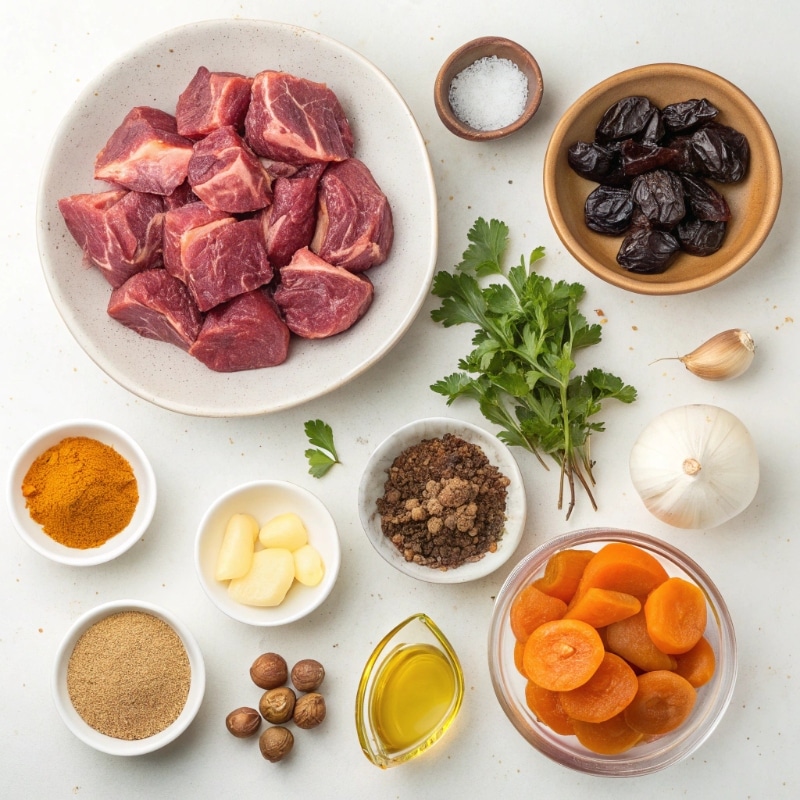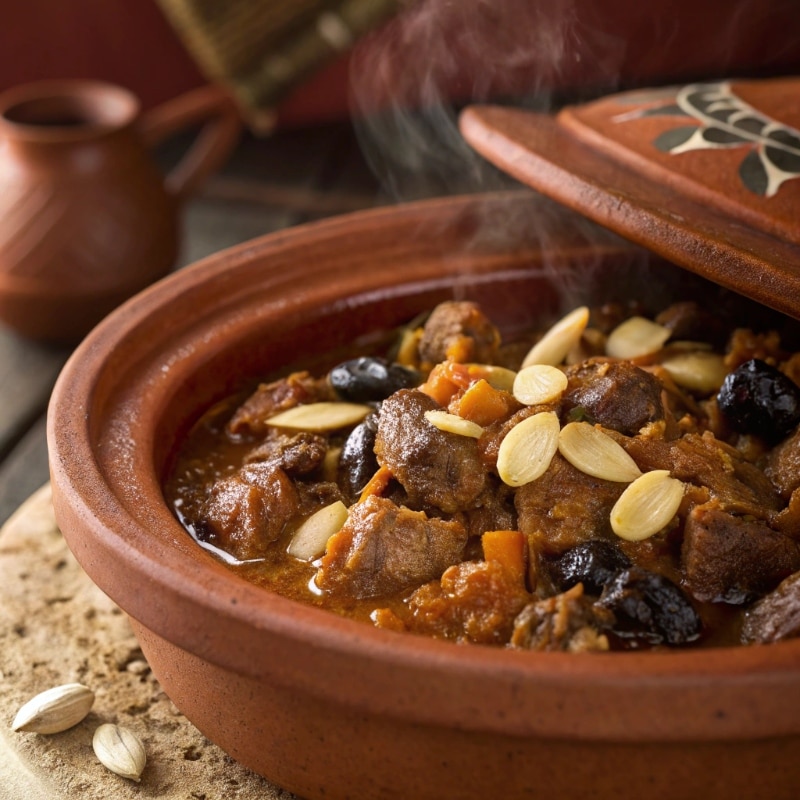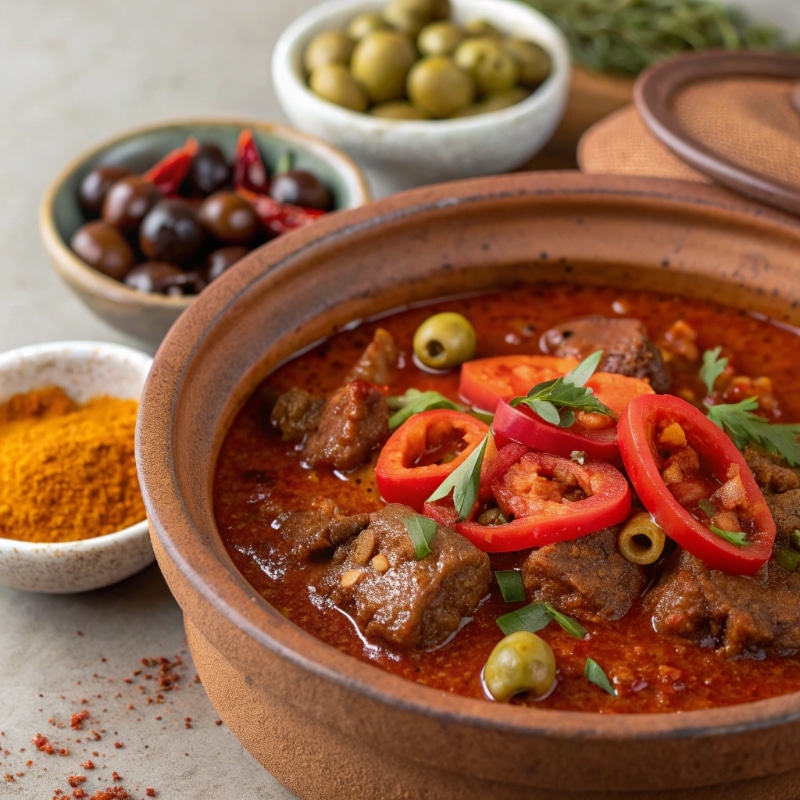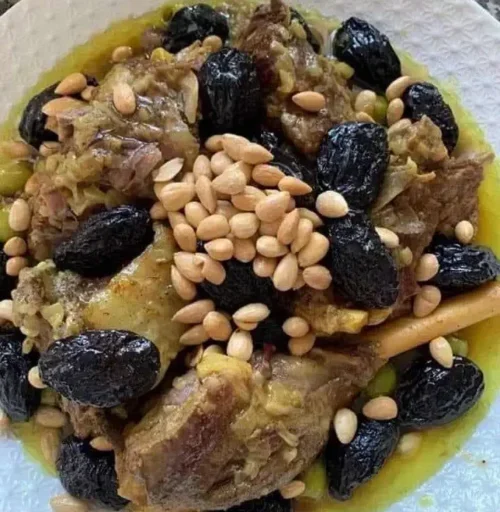Moroccan Lamb Tagine is a slow-cooked, aromatic stew made with tender lamb, warm spices, and a mix of sweet and savory ingredients. It is cooked in a traditional clay pot called a tagine, which helps to retain moisture and enhance the depth of flavors. This dish is a staple of Moroccan cuisine, known for its rich, spiced broth and melt-in-your-mouth lamb.
Table of Contents
Print Recipe
Traditional Moroccan Lamb Tagine
Equipment
- Tagine pot or Dutch oven
- Knife
- Cutting board
- Wooden spoon
Ingredients
For the Tagine
- 2 lbs lamb shoulder or leg Cut into chunks.
- 2 tbsp olive oil
- 1 large onion Finely chopped.
- 3 cloves garlic Minced.
- 1 tsp ground cumin
- 1 tsp ground cinnamon
- 1 tsp ground ginger
- ½ tsp ground turmeric
- ½ tsp paprika
- ½ tsp black pepper
- 1 tsp salt Adjust to taste.
- 2 cups beef or vegetable broth
- 1 cup diced tomatoes Canned or fresh.
- ½ cup dried apricots or prunes Chopped, for sweetness.
- ¼ cup almonds Toasted, for garnish.
- 2 tbsp fresh cilantro Chopped, for garnish.
- 2 tbsp fresh parsley Chopped, for garnish.
Instructions
- Heat olive oil in a tagine pot or Dutch oven over medium heat.
- Add the lamb chunks and sear on all sides until browned. Remove and set aside.
- In the same pot, sauté the chopped onion until soft and translucent. Add minced garlic and cook for another minute.
- Stir in cumin, cinnamon, ginger, turmeric, paprika, black pepper, and salt. Toast the spices for 30 seconds to release their aroma.
- Return the seared lamb to the pot. Add the broth, diced tomatoes, and dried apricots or prunes. Stir well to combine.
- Cover and simmer over low heat for 1.5 to 2 hours, or until the lamb is tender and the sauce has thickened.
- Garnish with toasted almonds, fresh cilantro, and parsley before serving.
- Serve hot with couscous, crusty bread, or rice.
Notes
The Cultural Significance of Tagine in Moroccan Cuisine
The tagine pot and the dish itself hold great cultural and historical importance in Morocco. The slow-cooking method allows spices and ingredients to blend beautifully, creating complex flavors that define Moroccan cooking. Tagines are often enjoyed during family gatherings, festive celebrations, and special occasions, making them a symbol of Moroccan hospitality.
Why Lamb is the Preferred Meat for This Dish
Lamb is commonly used in Moroccan tagines because of its rich, tender texture and ability to absorb spices. The natural fat in lamb enhances the depth of flavor, making it ideal for slow cooking. Additionally, lamb has been a staple meat in Moroccan cuisine for centuries due to its availability and cultural significance in Eid celebrations and traditional feasts.
Essential Ingredients for Moroccan Lamb Tagine
A great Moroccan Lamb Tagine is built on a foundation of high-quality ingredients, a balanced spice blend, and the perfect mix of sweet and savory flavors. Below are the essential ingredients that define this traditional dish.
1. The Best Cuts of Lamb for Tagine
The choice of lamb is crucial for achieving the tender, melt-in-your-mouth texture that makes tagine so special. Since this dish is slow-cooked, tougher cuts of lamb that contain more connective tissue work best, as they break down beautifully over time.
Recommended Cuts of Lamb for Tagine:
- Lamb Shoulder – Rich in fat and flavor, making it ideal for slow cooking.
- Lamb Shank – Contains bone marrow, which enhances the depth of flavor.
- Lamb Neck – Affordable and becomes tender when cooked slowly.
- Lamb Leg (Bone-In or Boneless) – A leaner option but still flavorful when cooked in a tagine.

2. Signature Spices: The Heart of Moroccan Flavor
Moroccan cuisine is famous for its complex spice blends that create a balance between warm, aromatic, and slightly sweet flavors. The key to an authentic Moroccan Lamb Tagine is using the right combination of spices.
Essential Spices in Moroccan Lamb Tagine:
- Cumin – Earthy and slightly smoky, it enhances the depth of flavor.
- Coriander – Adds a subtle citrusy undertone.
- Cinnamon – Brings warmth and a mild sweetness.
- Saffron – Known as “red gold,” it gives the dish a rich color and delicate aroma.
- Ginger – Provides a mild heat and warmth.
- Paprika – Adds a mild smokiness and color.
- Turmeric – Contributes an earthy flavor and enhances the dish’s golden hue.
- Ras el Hanout – A complex Moroccan spice blend that can contain over a dozen spices.
These spices are typically toasted lightly before being mixed into the dish, which helps release their essential oils and deepens their flavor.
3. Vegetables and Dried Fruits Commonly Used in Tagine
The magic of Moroccan Lamb Tagine lies in its ability to combine savory and sweet elements seamlessly.
Common Vegetables Used in Tagine:
- Onions – A base ingredient that caramelizes and enhances sweetness.
- Tomatoes – Add acidity and balance to the sauce.
- Carrots – Provide a slight natural sweetness and vibrant color.
- Potatoes – Absorb the rich sauce and add heartiness.
- Zucchini or Eggplant – Soften during cooking and contribute to the dish’s texture.
Dried Fruits for a Sweet-Savory Balance:
- Prunes – The most common addition, bringing a deep, caramelized sweetness.
- Apricots – Offer a tangy-sweet contrast.
- Dates – Provide natural sweetness and a hint of richness.
- Raisins or Figs – Add texture and subtle sweetness.
Dried fruits are typically rehydrated in warm water or broth before being added to the tagine to ensure they soften and release their natural sugars into the sauce.
4. Aromatics and Herbs for Extra Depth
- Garlic – Adds depth and a mild pungency.
- Fresh Cilantro & Parsley – Used as a garnish and for added freshness.
- Preserved Lemons – Provide a salty, citrusy burst of flavor.
5. Liquid Ingredients for a Rich and Flavorful Sauce
- Olive Oil – The base for sautéing aromatics and spices.
- Chicken or Beef Broth – Adds depth and richness to the sauce.
- Honey – Used in small amounts to enhance the dish’s natural sweetness.
6. Garnishes and Toppings
To complete the dish, Moroccan Lamb Tagine is often topped with:
- Toasted Almonds – Add crunch and a nutty flavor.
- Sesame Seeds – Used as a final touch for both texture and decoration.
The combination of tender lamb, fragrant spices, and a perfect balance of vegetables and dried fruits is what makes Moroccan Lamb Tagine a truly unforgettable dish.
How to Make Traditional Moroccan Lamb Tagine
Making Moroccan Lamb Tagine requires patience, quality ingredients, and the right cooking technique. Unlike other stews, tagine is slow-cooked in a traditional clay pot, allowing the flavors to develop gradually.
1. Preparing the Ingredients
Before cooking, it’s important to prepare all the ingredients properly. Lamb should be cut into medium-sized chunks, allowing it to absorb the spices while remaining tender during slow cooking. The vegetables should be chopped evenly so they cook at the same rate, while dried fruits like prunes or apricots should be soaked in warm water to soften.
Another essential step is marinating the lamb. This is done by rubbing it with a mixture of olive oil, crushed garlic, ground spices (cumin, coriander, cinnamon, turmeric, paprika, and ginger), and salt. Letting the lamb marinate for at least an hour—or preferably overnight—enhances the depth of flavor.
2. Building the Flavors in the Tagine Pot
The cooking process begins with heating olive oil in the base of the tagine pot over low to medium heat. The first layer of flavor is created by sautéing finely chopped onions and garlic until they become golden and fragrant. The marinated lamb is then added to the pot, searing it lightly to lock in its juices while allowing the spice coating to form a rich base for the sauce.
Once the lamb is browned, fresh or canned tomatoes are added to provide acidity and balance the richness of the meat. The dish is then layered with vegetables such as carrots, potatoes, zucchini, and bell peppers, ensuring that each bite is filled with a variety of textures and flavors.
3. The Slow-Cooking Process
Unlike quick stews, Moroccan Lamb Tagine relies on slow cooking over low heat to achieve tenderness. The dish is cooked covered for two to three hours, allowing the lamb to gradually absorb the fragrant spices while softening into a melt-in-your-mouth consistency. Unlike Moroccan Chicken Tagine, which cooks faster due to the delicate nature of chicken, lamb requires a longer cooking time to fully break down its connective tissues.
During the cooking process, liquid is added gradually. Instead of using a large amount of broth at the start, small additions of warm water or stock are made as needed to keep the sauce thick and flavorful. This technique prevents the tagine from becoming too watery while allowing the sauce to coat the meat and vegetables beautifully.
4. Adding the Sweet Elements
One of the most distinctive aspects of Moroccan Lamb Tagine is its balance between savory and sweet flavors. Dried fruits like prunes, apricots, or raisins are usually added in the last 30 minutes of cooking. Some recipes also call for a touch of honey or a cinnamon stick, which enhances the dish’s natural sweetness without overpowering it.
To elevate the dish further, preserved lemons and toasted almonds are sometimes incorporated. The lemons provide a slight tangy contrast, while the almonds add a crunchy texture to the otherwise soft and succulent dish.
5. Finishing Touches and Serving
As the tagine nears completion, the lid is removed to allow excess moisture to evaporate, thickening the sauce. The final step involves garnishing with fresh cilantro or parsley, which adds a bright, herbal freshness to the rich, spiced stew.
Moroccan Lamb Tagine is traditionally served with warm, freshly baked Moroccan bread (khobz) or fluffy couscous to soak up the flavorful sauce. The dish is presented directly in the tagine pot, allowing diners to enjoy it as it continues to simmer gently at the table.
Variations of Moroccan Lamb Tagine
While the classic Moroccan Lamb Tagine features slow-cooked lamb, aromatic spices, and a balance of savory and sweet ingredients, there are several regional and modern variations of this dish. Each version showcases different flavors, ingredients, and influences, making Moroccan lamb tagine a versatile dish that can be adapted to personal preferences.
1. Lamb and Prune Tagine (Tagine Lahlou)
One of the most traditional versions of Moroccan Lamb Tagine includes prunes, almonds, and a touch of cinnamon, creating a unique sweet and savory contrast. This version is often prepared for special occasions and celebrations, such as weddings and family gatherings.
Key Ingredients:
- Lamb (shoulder, shank, or leg)
- Prunes soaked in warm water
- Cinnamon and honey for sweetness
- Toasted almonds for crunch
- Sesame seeds as a garnish
Flavor Profile:
This tagine has a rich, slightly caramelized sauce that enhances the tender, slow-cooked lamb. The prunes soften and blend into the sauce, adding a deep, fruity sweetness that pairs perfectly with the warmth of cinnamon.

2. Lamb and Apricot Tagine
Similar to the prune version, this variation replaces prunes with dried apricots, giving the dish a slightly tangier and more citrusy flavor. Apricots, when simmered with lamb and spices, become soft and jam-like, blending naturally with the rich sauce.
Key Ingredients:
- Dried apricots soaked in broth or orange juice
- Ground ginger and turmeric for warmth
- Toasted almonds for texture
- A touch of honey to balance the flavors
Flavor Profile:
This tagine has a fruity brightness that contrasts with the richness of the lamb. The natural acidity of apricots complements the earthy spices, making it a lighter alternative to the prune version.
3. Spicy Lamb Tagine with Harissa
For those who prefer a bolder and spicier version, harissa—a North African chili paste—is added to the sauce. This variation is more popular in southern Morocco, where food tends to be spicier and more robust.
Key Ingredients:
- Harissa paste or chili flakes for heat
- Red bell peppers for sweetness
- Tomatoes to add depth to the sauce
- Fresh coriander for a fresh finish
Flavor Profile:
Unlike the sweet variations, this tagine has a spicy kick, with a deep, smoky richness. The lamb absorbs the heat from the harissa, making it perfect for those who enjoy bold, fiery flavors.

4. Lamb and Vegetable Tagine
For a more wholesome and balanced meal, some Moroccan households make a vegetable-rich lamb tagine by adding seasonal vegetables. This version is popular in rural areas, where fresh produce is a staple in daily meals.
Key Ingredients:
- Carrots, zucchini, and bell peppers
- Potatoes or sweet potatoes for heartiness
- Chickpeas for extra protein
- A mild spice blend with turmeric and coriander
Flavor Profile:
This tagine is light yet hearty, with the vegetables absorbing the flavorful sauce. It provides a nutrient-packed option for those who want a well-rounded meal without the sweetness of prunes or apricots.
5. Modern Adaptations of Moroccan Lamb Tagine
While traditional tagine recipes have been passed down for generations, modern chefs have created new takes on the dish, experimenting with different flavors and cooking techniques.
Examples of Modern Twists:
- Lamb Tagine with Quinoa: A healthier version that replaces couscous with protein-rich quinoa.
- Slow-Cooker Lamb Tagine: Uses a slow cooker instead of a traditional tagine pot for convenience.
- Mediterranean-Inspired Lamb Tagine: Adds olives, sun-dried tomatoes, and feta cheese for a fusion of Moroccan and Mediterranean flavors.
Conclusion
Moroccan Lamb Tagine is a timeless and deeply flavorful dish that showcases the best of Moroccan culinary traditions. Slow-cooked to perfection, this dish blends aromatic spices, tender lamb, and a mix of sweet and savory elements to create an unforgettable meal. Whether enjoyed for a special occasion or as a comforting family dinner, lamb tagine offers a rich, satisfying taste that is both authentic and versatile.
Moroccan Lamb Tagine is more than just a dish it is a cultural experience that reflects the history, hospitality, and rich flavors of Morocco. Whether you’re making a traditional version or experimenting with modern variations, this dish will undoubtedly become a favorite at your table.
To learn about: health benefits of lamb
For more Moroccan Recipes to Try
Check out these recipes:
- Amlou: The best Moroccan Almond and Argan Oil Spread Recipe
- 7 Moroccan Couscous Recipes: Authentic Recipes, Variations, and Health Benefits


